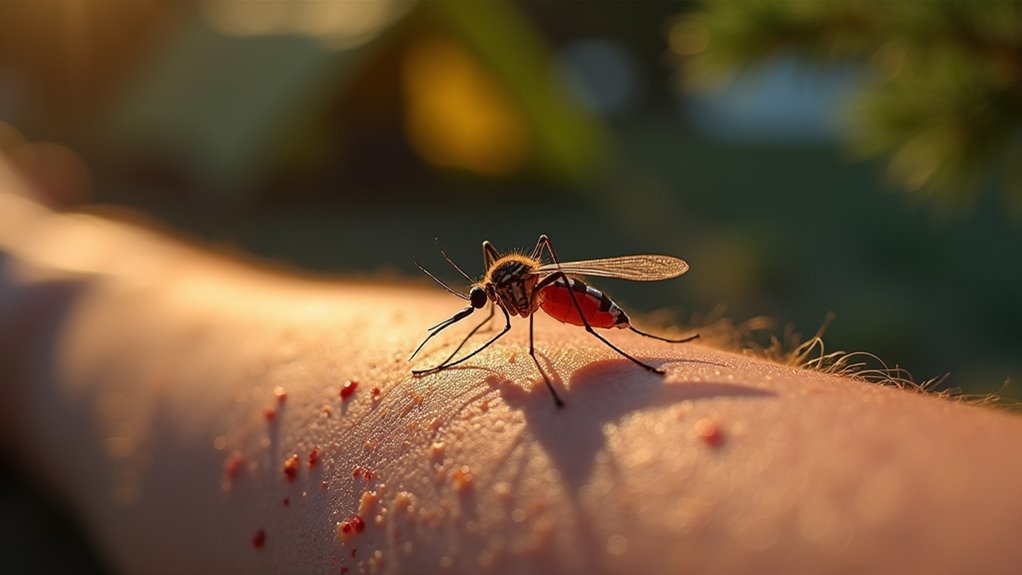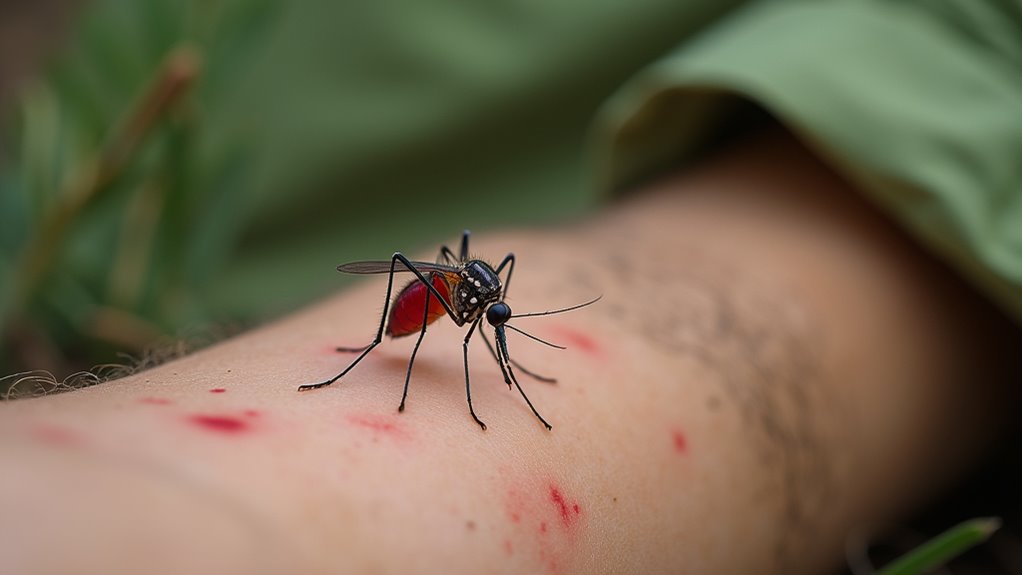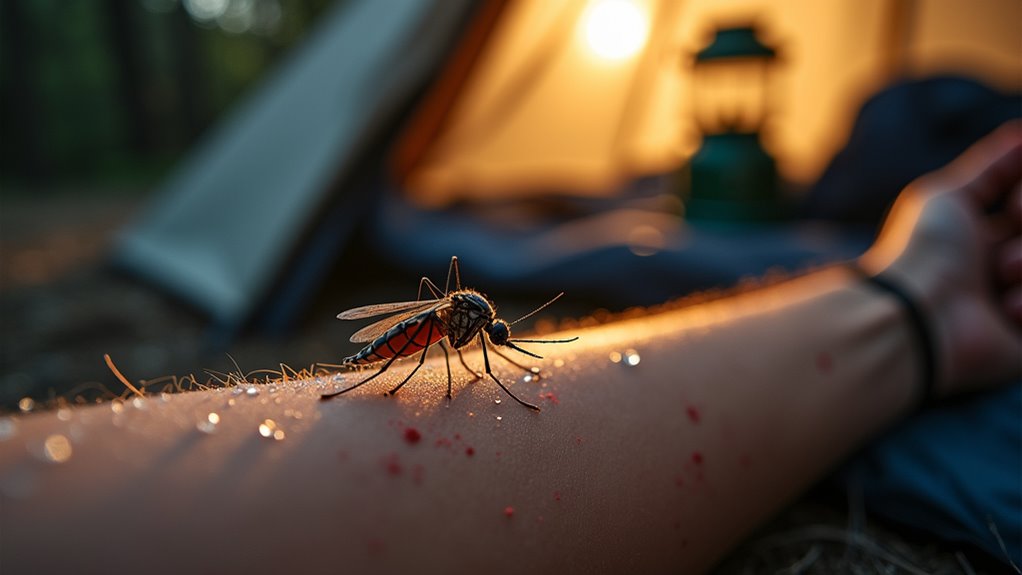Physical Address
304 North Cardinal St.
Dorchester Center, MA 02124
Physical Address
304 North Cardinal St.
Dorchester Center, MA 02124

Get ready to discover the shocking diseases lurking in common camping insects that could ruin your outdoor adventure forever.
You’ve planned the perfect camping trip, but there’s one thing that could turn your outdoor adventure into a health nightmare: disease-carrying insects. Those seemingly harmless mosquito and tick bites aren’t just annoying—they can transmit serious illnesses like West Nile virus, Lyme disease, and Zika that’ll affect you long after you’ve packed up your tent. Here’s what you need to know to protect yourself before you head into the wilderness.

When you’re setting up camp in the wilderness, you’ll likely encounter several insects that can transmit serious diseases through their bites. Mosquitoes top the list, carrying West Nile virus, Zika, and eastern equine encephalitis. They’re most active during dawn and dusk hours near water sources.
Mosquitoes carrying West Nile virus, Zika, and eastern equine encephalitis pose the greatest threat to wilderness campers.
Ticks pose another major threat, transmitting Lyme disease, Rocky Mountain spotted fever, and ehrlichiosis. You’ll find them in tall grass, brush, and wooded areas where they wait to latch onto passing hosts.
Black flies can spread river blindness in certain regions, while deer flies may carry tularemia. Sand flies, common in desert camping areas, transmit leishmaniasis.
These insects don’t just cause irritating bites—they’re potential vectors for diseases that can seriously impact your health long after your camping trip ends. Understanding proper wildlife safety protocols during summer camping helps minimize your exposure to these disease-carrying insects.
Since insect-borne diseases can take days or weeks to manifest symptoms, you’ll need to stay vigilant long after returning from your camping trip.
Watch for fever, headaches, and muscle aches – these are common early warning signs across most insect-borne illnesses. If you develop a rash, especially one that spreads outward from a bite site, don’t ignore it.
Tick-borne diseases like Lyme often produce distinctive bull’s-eye patterns.
Pay attention to sudden fatigue, joint pain, or swollen lymph nodes. Mosquito-borne viruses can cause nausea, vomiting, and neurological symptoms like confusion or sensitivity to light.
Keep track of when and where you camped. If symptoms appear within 30 days, tell your doctor about potential insect exposure immediately.
Early treatment dramatically improves outcomes for most insect-borne diseases. Proper low impact camping practices can help reduce your exposure to disease-carrying insects while protecting the natural environment.

Prevention beats treatment every time when it comes to insect-borne diseases. Your first line of defense is choosing the right repellent and using it correctly.
DEET-based repellents remain the gold standard, offering 6-12 hours of protection against mosquitoes, ticks, and flies. Apply 20-30% DEET concentration for most camping situations.
Picaridin works equally well with less odor and skin irritation—perfect if you’re sensitive to DEET.
Don’t forget proper application technique. Cover all exposed skin thoroughly, including ankles, wrists, and behind ears. Reapply every 4-6 hours or after swimming and heavy sweating.
Never spray directly on your face; instead, apply to hands first, then pat onto facial areas.
For gear protection, treat clothing and tents with permethrin before your trip. This creates a protective barrier that lasts through multiple washes.
If you’re planning extended outdoor adventures, consider whether renting or buying specialized gear makes more sense for your budget and frequency of use.
While repellents work hard to keep bugs away, your clothing choices create an equally important physical barrier against bites. Wear long-sleeved shirts and pants, especially during dawn and dusk when mosquitoes are most active.
Light-colored clothing makes it easier to spot ticks and attracts fewer insects than dark colors.
Tuck your shirt into your pants and your pants into your socks to eliminate entry points. This might look awkward, but it’s incredibly effective against ticks and chiggers.
Choose tightly woven fabrics that bugs can’t penetrate. Permethrin-treated clothing adds extra protection – you can buy pre-treated gear or treat your own clothes.
A wide-brimmed hat protects your head and neck, while closed-toe shoes prevent foot bites. Pack extra socks since wet feet attract more insects.
Consider packing a lightweight camping headnet for additional face protection when bugs are particularly aggressive or when you’re in heavily infested areas.

Where you pitch your tent makes all the difference in your battle against biting insects. Avoid camping near stagnant water sources like ponds, marshes, or slow-moving streams where mosquitoes breed. Choose elevated, breezy locations since wind naturally deters flying insects. Open meadows or ridgelines work better than dense forests where bugs congregate.
Set up camp before dusk when mosquito activity peaks. Position your tent away from flowering plants that attract various insects. Avoid areas with decaying organic matter or animal droppings that draw flies and other pests.
Create a buffer zone by clearing vegetation around your campsite. Keep food sealed and dispose of waste properly – crumbs and food odors attract ants, flies, and other unwanted visitors. Scout potential sites during daylight to identify insect activity patterns before committing to your spot. During winter camping adventures, insect activity is naturally reduced due to cold temperatures, making it an ideal time for bug-sensitive campers to enjoy the outdoors.
Once you’ve secured the perfect campsite, you can harness nature’s own pest control methods to create an insect-free zone around your temporary home. Plant aromatic herbs like citronella, lavender, and peppermint around your tent’s perimeter – their natural oils repel mosquitoes and flies effectively.
Transform your campsite into a natural fortress against bugs by strategically planting citronella, lavender, and peppermint around your tent’s perimeter.
You’ll find that burning sage or rosemary branches in your campfire creates smoke that drives away most flying insects.
Essential oils work wonders too. Mix tea tree, eucalyptus, or lemon oil with water in a spray bottle and mist your camping area regularly.
Coffee grounds sprinkled around your site deter ants and crawling insects.
Marigolds planted in portable containers provide ongoing protection, while cedar chips create natural barriers.
These methods aren’t just effective – they’re environmentally friendly and won’t contaminate your food or water supplies. Taking this extra care with natural deterrents will significantly enhance your overall camping experience.

Despite your best prevention efforts, insect bites will happen during camping trips, and knowing how to treat them properly can mean the difference between minor discomfort and serious complications.
First, clean the bite area with soap and water to prevent infection.
Apply a cold compress for 10-15 minutes to reduce swelling and numb the pain.
Don’t scratch – you’ll only make it worse and risk introducing bacteria.
For immediate relief, try these proven remedies: calamine lotion, antihistamine cream, or even a paste made from baking soda and water.
If you’re dealing with multiple bites or severe itching, take an oral antihistamine like Benadryl.
Watch for warning signs of allergic reactions: difficulty breathing, widespread swelling, or hives.
Seek medical attention immediately if these symptoms develop.
Remember that maintaining proper camping hygiene practices while treating bites will help prevent secondary infections and promote faster healing.
While most insect bites heal without complications, certain symptoms that develop hours or days after your camping trip shouldn’t be ignored. You should seek immediate medical attention if you experience fever, chills, muscle aches, or fatigue that wasn’t present during camping. These could signal tick-borne diseases like Lyme disease or Rocky Mountain spotted fever.
Watch for expanding red rashes, especially bullseye patterns around bite sites. Don’t wait if you develop severe headaches, joint pain, or unusual weakness. Mosquito bites can transmit West Nile virus, causing flu-like symptoms.
If bite areas become increasingly swollen, hot, or develop pus streaks, you’re likely dealing with bacterial infection. Trust your instincts—you know your body best. When something feels seriously wrong after camping, get professional medical evaluation promptly. Prevention is always better than treatment, so implementing proper camping safety measures during your outdoor adventures can help minimize exposure to disease-carrying insects.
You’ve got the tools to stay protected from disease-carrying insects while camping. Like a shield protecting a warrior, your combination of repellents, proper clothing, and smart campsite choices will keep dangerous bugs at bay. Don’t forget to monitor yourself for symptoms after you return home – early detection can make all the difference. Trust your instincts and seek medical help if something doesn’t feel right. You’re now ready for safer outdoor adventures.